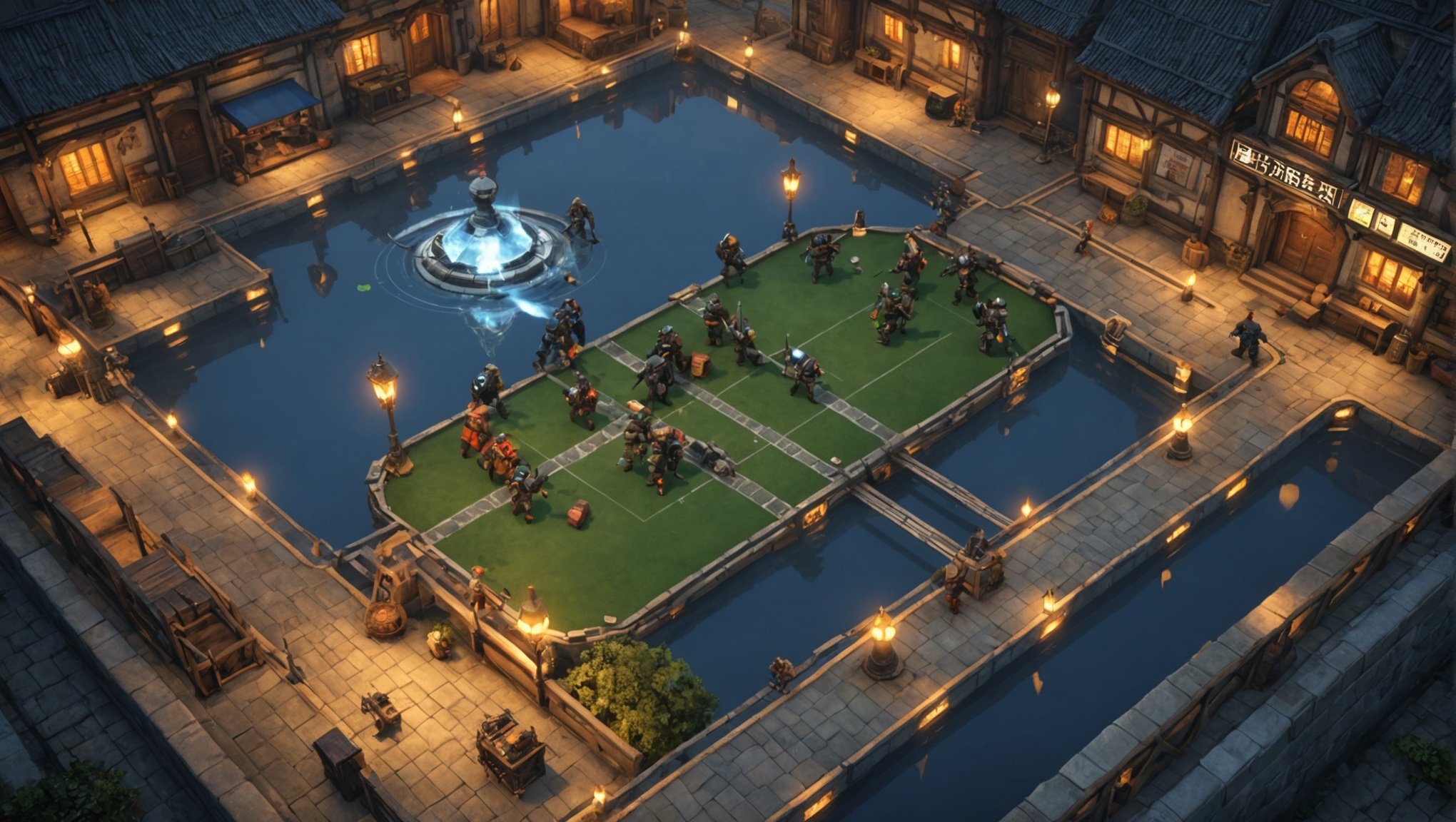Mastering Real-Time Language Translation in Multiplayer Games: Top Strategies for Success
In the ever-evolving gaming industry, the ability to facilitate real-time language translation in multiplayer games has become a crucial aspect of enhancing the global gaming experience. This feature not only expands the game’s reach but also fosters a more inclusive and engaging environment for players from diverse linguistic backgrounds. Here, we delve into the top strategies for achieving successful real-time language translation in multiplayer games.
Understanding the Challenges of Real-Time Translation
Real-time language translation in multiplayer games is a complex task that involves several challenges. Here are some of the key issues game developers face:
Topic to read : Essential Safety Measures for Effective VR Mental Health Therapy Games: A Comprehensive Guide
High-Dimensional State Spaces and Complexity
In games, especially those with real-time strategy or multiplayer components, the state space can be incredibly high-dimensional. This complexity is exacerbated by the need for real-time decision-making and communication among players. As noted in the context of reinforcement learning, traditional methods often struggle with high-dimensional state spaces and complex environments.
Hidden Information and Multimodal Data
Games like poker, which involve hidden information and multimodal interactions, present unique challenges. For instance, the poker AI Pluribus had to deal with hidden cards, multiplayer setups, and complex betting structures, all of which required advanced strategies like Monte Carlo counterfactual regret minimization and real-time search algorithms.
This might interest you : Unleashing Realism: Strategies for Developers to Enhance NPC Responses in Horror Games Using AI
Natural Language Understanding
Natural language processing (NLP) is another significant hurdle. Deep reinforcement learning (RL) faces difficulties in understanding the nuances and complexities of human language, which are essential for effective communication in multiplayer games.
Leveraging Advanced Technologies
To overcome these challenges, game developers are leveraging several advanced technologies.
Reinforcement Learning and Deep Neural Networks
Reinforcement learning, combined with deep neural networks, has proven to be highly effective in developing AI agents that can handle complex game environments. For example, the AlphaStar agent, developed by DeepMind, uses a combination of supervised learning, self-play, and a virtual league to optimize strategies against various opponents.
Large Language Models and Machine Translation
Large language models, such as GPT, have revolutionized machine translation. These models can be integrated into games to provide real-time translation capabilities. For instance, language-conditional RL, where natural language is part of the state and action space, can guide agents’ actions and decisions within the language environment.
Effective Localization Strategies
Localization is a critical aspect of ensuring that games are accessible to a global audience. Here are some effective localization strategies:
Target Audience and Cultural Sensitivity
Understanding the target audience and their cultural nuances is vital. Game developers must ensure that the content is not only translated but also culturally adapted to avoid any misunderstandings or offenses.
- Conduct market research to understand the target audience.
- Use local translators who are familiar with the culture.
- Test the game with local players to gather feedback.
- Ensure that all content, including text, audio, and visuals, is culturally sensitive.
Translation Memory and Human Translators
Using translation memory can significantly reduce the time and cost associated with translation. However, human translators are still essential for ensuring the quality and accuracy of the translation.
- Implement translation memory to reuse previously translated content.
- Collaborate with human translators to review and refine automated translations.
- Use machine translation for initial drafts and then have human translators edit and finalize.
Real-Time Translation Tools
Integrating real-time translation tools into the game can enhance the player experience. These tools can translate text, voice chat, and even subtitles in real-time.
- Use cloud-based translation services that can handle real-time requests.
- Implement APIs that can integrate with the game’s chat system.
- Ensure low latency to maintain a seamless gaming experience.
Marketing and Community Engagement
Effective marketing and community engagement are crucial for the success of any game, especially when it comes to a global audience.
Social Media and App Store Optimization
Social media platforms and app store listings are key channels for reaching a global audience. Ensuring that the game’s marketing content is translated and localized can significantly improve its visibility.
- Translate and localize all marketing materials, including social media posts and app store descriptions.
- Use localized keywords to improve app store search visibility.
- Engage with local gaming communities through social media and forums.
Community Feedback and Support
Community feedback is invaluable for improving the game and its translation. Providing support in multiple languages can also enhance player satisfaction.
- Offer multilingual support through customer service channels.
- Encourage community feedback and use it to improve the game’s localization.
- Regularly update the game with new translations and fixes based on community feedback.
Practical Insights and Actionable Advice
Here are some practical insights and actionable advice for game developers looking to master real-time language translation in their games:
Balance Automation and Human Touch
While machine translation can handle a significant portion of the translation workload, it is crucial to balance this with human oversight to ensure accuracy and cultural sensitivity.
- Use machine translation for initial translations but have human translators review and edit.
- Implement a feedback loop where players can report translation errors.
- Continuously update and refine translations based on player feedback.
Focus on Player Experience
The ultimate goal of real-time language translation is to enhance the player experience. Ensuring that the translation is seamless and does not disrupt gameplay is paramount.
- Conduct thorough testing to ensure that the translation does not introduce any lag or bugs.
- Use user-friendly interfaces that make it easy for players to switch between languages.
- Provide options for players to customize their language preferences.
Examples and Anecdotes
Several games have successfully implemented real-time language translation, offering valuable lessons for other developers.
AlphaStar and Pluribus
The development of AlphaStar and Pluribus, AI agents that excel in complex games like StarCraft II and poker, respectively, demonstrates the power of advanced technologies in handling complex interactions. These agents use sophisticated algorithms to communicate and strategize, which can be adapted for real-time language translation in multiplayer games.
Noun Town Language Learning
Games like Noun Town, which focus on language learning, use real-time translation and interactive elements to engage players. This approach can be applied to multiplayer games to create a more inclusive environment where players can communicate across language barriers.
Mastering real-time language translation in multiplayer games is a multifaceted challenge that requires a combination of advanced technologies, effective localization strategies, and a focus on player experience. By leveraging reinforcement learning, large language models, and human translators, game developers can create a seamless and inclusive gaming environment for players worldwide.
| **Technology** | **Description** | **Benefits** |
|
|---------------------------------------------------------------------------------|
|
| Reinforcement Learning | Uses trial and error interactions to optimize strategies. | Handles high-dimensional state spaces and complex environments. |
| Large Language Models | Integrates natural language processing for real-time translation. | Provides accurate and context-aware translations. |
| Translation Memory | Reuses previously translated content to reduce translation time and cost. | Improves efficiency and consistency in translations. |
| Human Translators | Ensures quality and accuracy of translations. | Adds cultural sensitivity and nuance to translations. |
| Real-Time Translation Tools| Translates text, voice chat, and subtitles in real-time. | Enhances player experience by facilitating cross-language communication. |
In the words of Mandy Fong, a game localization expert, “Effective game localization is not just about translating text; it’s about creating a seamless experience that respects the cultural and linguistic nuances of the target audience.” By adopting these strategies, game developers can ensure that their games are not only globally accessible but also deeply engaging for players from all over the world.










